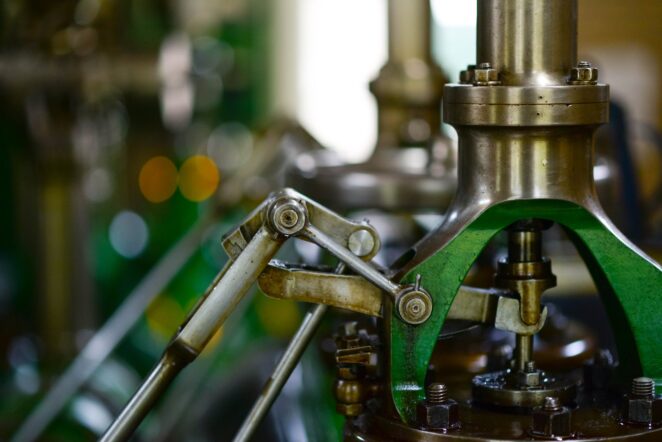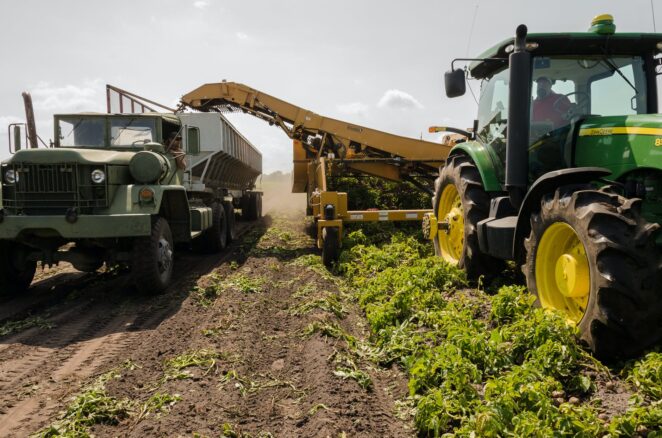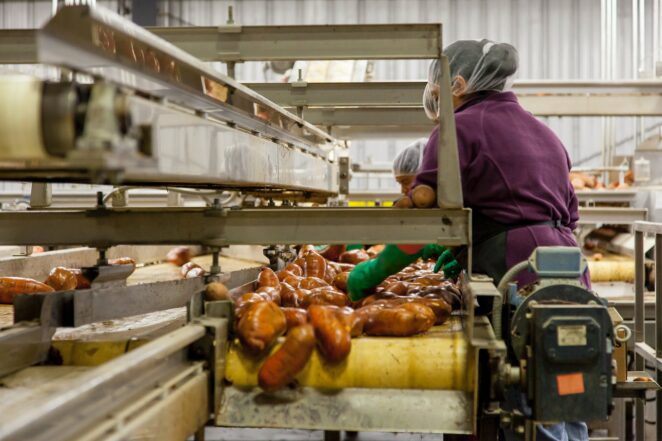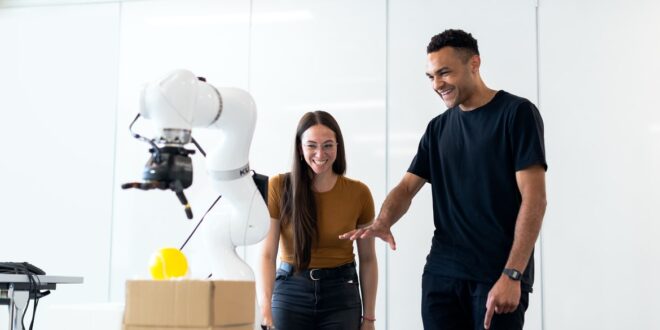What once seemed like a far-off fantasy has now become a reality — robots are involved in our everyday lives.
On a consumer level, robots and artificial intelligence systems have become household staples, from automated vacuums to Google Homes. On an industrial level, robots and AI processes are helping different industries in a variety of ways.
In some cases, robots are taking over tedious jobs to replace humans, and in other cases, robots are working alongside humans to help, but not completely taking over jobs. Robots that work in tandem with humans are called “cobots.”
Robotics, cobots, and AI systems are all helping different industries improve the safety of human workers, increase efficiencies, reduce costs, and much more.
Let’s dive into how robots are lending helping a helping hand in healthcare, manufacturing, agriculture, construction, and food service.
Healthcare

In the healthcare field, robots are making processes more efficient on small and large scales.
On the mundane side of healthcare tasks, robots are helping restock and transport medications and supplies. While restocking supplies doesn’t sound like much help, it makes a difference for care teams.
According to MedCityNews, “Nurses are spending more time on indirect patient care activities like paperwork, traveling to supply rooms, and entering medication orders than in the past.” When nurses and doctors spend most of their day taking inventory or hunting down supplies, they are spending less time on patient care. Some nurses reported spending at least 2 hours a day on indirect patient care. If those two hours can be freed up to see more patients, it’s a win-win for everyone.
Another way robots are easing the schedules of doctors and nurses is by assisting patients as they get out of bed.
Robots are also taking over more serious tasks, like incisions during surgery. When robots are used for incisions, they work more precisely and leave less damage than human hands do. Plus, at a certain scale, some incisions are too small for even the steadiest human hand.
Microbots are also being used in the medical field to detect and treat diseases. Essentially, a patient will swallow a tiny camera so that doctors can take images of certain areas — like the colon — to detect tumors. Using microbots is a minimally invasive way to help patients.
Manufacturing

One of the biggest ways robots are helping the manufacturing industry is by automating processes and cutting costs.
Not only do robots speed up assembly processes, but they also take humans out of dangerous processes. Robots are helping in almost all parts of assembly lines — moving parts, gluing pieces together, guiding parts, and more.
Robots are also increasing workplace safety and keeping humans out of harm’s way. Robots don’t get tired after a 15-hour shift like humans do, which means they can work longer hours while keeping the same accuracy. AI systems are also being used to detect any machine malfunctions and shut them down or alert workers before anyone gets hurt.
Beyerdynamic, an audio accessories manufacturer in Germany, implemented two assembly line robots that increased the production rate by 50%. Even with limited floor space in their factory, human workers could easily work alongside these robots to do their tasks.
Robots also have a relatively quick ROI. Within two years, most robots and automated systems will pay for themselves. This also saves companies money, since they don’t have to pay human workers on the floor when robots take over tasks.
Agriculture

Another industry using robotics to increase productivity and lower costs is agriculture. Robots are helping farmers by getting tedious, repetitive tasks off their plates so they can spend their precious time on more pressing matters that keep the business running smoothly.
Farmers are using self-guided harvesters and tractors. The machines are guided by a GPS, automating major operations like mowing, spraying, weed removal, and pruning. Robotic devices are also being used to pick fruit and crops. One company, Energid, has increased its picking rate by approximately 50%, and sensor technologies are used to check crops for pests or diseases that affect crops.
Drones are used on farmlands to get an aerial view of crops, harvests, and fields in real-time. Using drones for surveying land helps free up farmers’ time since they don’t have to go out into their land (which could be many acres) to check on a single section of crops. More sophisticated drones and software, like one from PrecisionHawk, “automatically converts aerial data into an easier-to-understand analysis. It provides orthomosaics, 3D models, crop health analysis tools, volume measurement, and the ability to collect, process, manage, share and analyze aerial data. In addition, the software allows users to communicate and collaborate with team members.”
Construction, Oil, and Gas

In industries like construction and oil & gas, robots are helping immensely by keeping human workers out of dangerous situations and taking over tedious tasks.
Robots are used for more tedious (but essential) tasks like bricklaying. Robots that lay bricks account for many environmental factors while performing the job, like wind and vibrations, to build the sturdiest and most efficient structure possible. Robots are also being used to paint, enabling human workers to focus on more critical tasks.
In the oil & gas industry, robots are taking over hazardous tasks like industrial tank cleaning. Any container or tank holding oil needs to be cleaned. The traditional method includes a human entering the tank and manually cleaning it, putting the worker in a very dangerous confined space. Instead, tank cleaning robots from Ecorobotics enable humans to control the tank cleaning robots remotely, leaving humans out of the hazardous parts of tank cleaning tasks.
Food

Robots are helping the food industry in many ways as well.
Domino’s Pizza has a self-driving delivery car that delivers pizza to residential homes, while Little Caesar’s has a patented robotic arm that helps make pizza in-store. Their robot spreads dough, adds toppings, and places pizzas in the oven. Utilizing robots in both of these instances helps limit the spread of germs. Touchless contact is in heavy demand post-pandemic, and robots are helping support this development.
In China, a robot called Cruzr is being utilized in grocery stores to recommend wine pairings to shoppers that accompany the food they’re buying.
Robotics Are Here To Stay
Robots are becoming more and more popular to help streamline processes, take over mundane tasks, increase productivity, and lower costs for many industries. You can expect to see even more robots in everyday life; they’re here to stay, and the robotics industry is only growing.
 Vermont Republic Second Vermont Republic
Vermont Republic Second Vermont Republic




